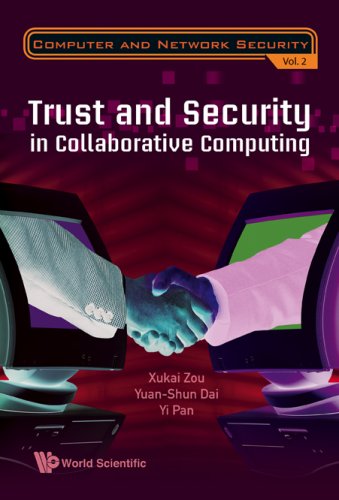(Ebook PDF) Trust and security in collaborative computing 1st edition by Xukai Zou ISBN 9789812790880 9812790888 full chapters
$50.00 Original price was: $50.00.$35.00Current price is: $35.00.
Trust and security in collaborative computing Xukai Zou Digital Instant Download
Author(s): Xukai Zou, Yuan-shun Dai, Yi Pan
ISBN(s): 9789812790880, 9812790888
Edition: illustrated edition
File Details: PDF, 2.41 MB
Year: 2008
Language: english
(Ebook PDF) Trust and security in collaborative computing 1st edition by Xukai Zou-Ebook PDF Instant Download/Delivery:9789812790880, 9812790888
Instant download Full Chapter of Trust and security in collaborative computing 1st edition after payment

Product details:
ISBN 10:9812790888
ISBN 13:9789812790880
Author: Zou Xukai
Computer networks are compromised by various unpredictable factors, such as hackers, viruses, spam, faults, and system failures, hindering the full utilization of computer systems for collaborative computing — one of the objectives for the next generation of the Internet. It includes the functions of data communication, resource sharing, group cooperation, and task allocation. One popular example of collaborative computing is grid computing.This monograph considers the latest efforts to develop a trusted environment with the high security and reliability needed for collaborative computing. The important modules treated include secure group communication, access control, dependability, grid computing, key management, intrusion detection, and trace back. In addition, a real project for developing a nationwide medical information system with high dependability and security is described.
Table of Contents:
- 1. Introduction
- 1.1 Overview of Trusted Collaborative Computing
- 1.2 Basic Concepts in Terms of Security
- 1.3 Basic Concepts in Terms of Reliability
- 1.4 Abbreviations and Notations
- 1.5 Outline
- 2. Secure Group Communication (SGC)
- 2.1 Overview of Secure Group Communication (SGC)
- 2.2 Typical Group Key Management Schemes for SGC
- 2.2.1 Centralized Group Key Distribution
- 2.2.1.1 Key Tree (Logical Key Hierarchy)
- 2.2.1.2 Other Proposed Schemes
- 2.2.2 De-centralized Group Key Management
- 2.2.2.1 Iolus
- 2.2.2.2 Other Proposed Schemes
- 2.2.3 (Distributed) Contributory Group Key Agreement
- 2.2.3.1 Tree based Group Di.e-Hellman Key Agreement
- 2.2.3.2 Other Proposed Schemes
- 2.2.4 Distributed Group Key Distribution
- 2.2.4.1 DGKD
- 2.3 Enhanced Group Key Management for SGC
- 2.3.1 SGC for Wireless and Mobile Ad Hoc Networks
- 2.3.1.1 CRTDH
- 2.3.1.2 Other Proposed Schemes
- 2.3.2 Authenticated Key Exchange (AKE)
- 2.3.2.1 AUTH-CRTDH
- 2.3.2.2 Other Proposed Schemes
- 2.3.3 Self-Healing Key Distribution
- 2.3.3.1 Self-Healing based on Polynomials and Secret Sharing
- 2.3.3.2 Other Proposed Schemes
- 2.3.4 Block-free Group Key Management
- 2.3.4.1 BF-TGDH
- 2.3.5 Secure Dynamic Conferencing
- 2.3.5.1 KTDCKM-SDC
- 2.3.5.2 Other Proposed Schemes
- 2.4 Conclusion
- 3. Cryptography based Access Control
- 3.1 Overview of Access Control in Collaborative Computing
- 3.2 An Efficient Differential Access Control (DIF-AC) Scheme
- 3.2.1 System Description and Initialization
- 3.2.2 System Dynamics and Maintenance
- 3.2.3 Discussion
- 3.3 Cryptographic Hierarchical Access Control (CHAC) Schemes
- 3.3.1 HACModel
- 3.3.2 Directly Dependent Key Schemes
- 3.3.3 Indirectly Dependent Key Schemes
- 3.3.4 Polynomial and Interpolation based Schemes
- 3.3.5 An E.cient CHAC Scheme with Locality
- 3.4 A Uniform CHAC Scheme Based on Access Polynomials
- 3.4.1 Principle
- 3.4.2 Key Computation/Derivation
- 3.4.3 Node/Vertex Level Dynamics
- 3.4.4 User Level Dynamics
- 3.4.5 Security and Performance Analysis
- 3.4.5.1 Security Analysis
- 3.4.5.2 Performance Analysis
- 3.4.6 An Illustrative Example and Experiment Results
- 3.4.7 Discussion
- 3.4.7.1 Enforcement of Other Access Models
- 3.5 Conclusion
- 4. Intrusion Detection and Defense
- 4.1 Overview of Intrusion Detection and Defense
- 4.2 Intruding Attacks
- 4.3 Intrusion DetectionModels
- 4.3.1 AnomalyModeling
- 4.3.2 MisuseModeling
- 4.3.3 Specification Modeling
- 4.4 Intrusion Response
- 4.5 DoS/DDoS Attacks
- 4.5.1 Typical DoS Attacks
- 4.5.1.1 DoS Flooding Attacks
- 4.5.1.2 Redirection Attacks
- 4.5.1.3 Service Exploits
- 4.5.2 Distributed Denial of Service (DDoS) Attacks
- 4.5.2.1 DDoS Attack Steps
- 4.5.2.2 DDoS Tools
- 4.6 Typical DoS/DDoS Defense Mechanisms
- 4.6.1 Single-node Defending Method
- 4.6.2 Multiple-node Defending Methods
- 4.6.2.1 Path Identi.cation
- 4.6.3 Honeypot
- 4.7 Defending against DoS/DDoS Attacks–Traceback
- 4.7.1 ICMP Traceback.
- 4.7.2 (Probabilistic) IP Packet Marking
- 4.7.3 Hash Based Traceback
- 4.7.4 Hybrid Approach
- 4.7.4.1 Distributed Linked List Traceback (DLLT)
- 4.7.4.2 Probabilistic Pipelined Packet Marking (PPPM)
- 4.7.5 Intrusion Detection and Traceback in Wireless Networks
- 4.7.6 Pushback
- 4.8 Exemplary DoS/DDoS Defense Research Projects and Systems
- 4.8.1 Best Practice Methods
- 4.8.2 D-Ward
- 4.8.3 Netbouner
- 4.8.4 DefCom
- 4.8.5 SIFF
- 4.8.6 Hop-Count Filtering
- 4.8.7 PacketScore
- 4.8.8 Speak-Up
- 4.9 Secure Overlay Service (SOS)
- 4.10 Conclusion
- 5. Reliability in Grid Computing
- 5.1 Overview of Reliability in Grid Computing
- 5.2 Grid Service Reliability and Performance
- 5.2.1 Description of the Grid Computing
- 5.2.2 Failure Analysis of Grid Service
- 5.2.3 Grid Service Reliability and Performance
- 5.2.4 Grid Service Time Distribution and Indices
- 5.3 Star Topology Grid Architecture
- 5.3.1 Universal Generating Function
- 5.3.2 Illustrative Example
- 5.4 Tree Topology Grid Architecture
- 5.4.1 Algorithms for Determining the pmf of the Task Execution Time
- 5.4.1.1 Minimal Task Spanning Tree (MTST)
- 5.4.1.2 pmf of the Task Execution Time
- 5.4.2 Illustrative Example
- 5.4.2.1 The Service MTST
- 5.4.2.2 Parameters of MTSTs’ Paths
- 5.4.2.3 List of MTST Elements
- 5.4.2.4 pmf of Task Completion Time
- 5.4.2.5 Calculating the Reliability Indices.
- 5.4.3 Parameterization and Monitoring
- 5.5 Conclusion
- 6. Security in Grid Computing
- 6.1 Overview of Security in Grid Computing
- 6.2 Existing Research on Grid Computing Security
- 6.3 Secure Grid Communication and Controlled Resource Sharing in Grid Computing
- 6.4 Dual-Level Key Management (DLKM)
- 6.4.1 First Level
- 6.4.2 Second Level
- 6.4.3 Combination of Two Levels
- 6.4.4 Security and Algorithm Analysis
- 6.4.4.1 Security Analysis
- 6.4.4.2 Complexity Analysis
- 6.5 Secure Grid Computing by DLKM
- 6.5.1 Access Local Resources
- 6.5.2 Access Remote Resources
- 6.5.3 Data Grid
- 6.5.4 Non-Monitored Grid Service
- 6.5.5 An Illustrative Example
- 6.5.5.1 Initialization
- 6.5.5.2 Illustration of DLKM for a Grid Service
- 6.6 Conclusion
- 7. Trusted and Seamless Medical Information Systems
- 7.1 Overview of Trusted and Seamless Medical Information Systems
- 7.2 Health Information Technology and Medical Information System
- 7.3 Architecture of the Proposed Secure MIS
- 7.3.1 System Architecture
- 7.3.2 Security Functions Supported by ACP
- 7.3.3 Tele-medicine Service .
- 7.3.4 Additional Features Resulting from the ACP Mechanism
- 7.4 Dependable MIS based on Grid Computing Technology
- 7.5 Conclusion
People also search:
trustworthy computing initiative
trust and security
trust and collaboration
collaborative security
trustworthy computing definition
Tags:
Zou Xukai,Trust,security,collaborative computing


